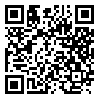Volume 15, Issue 6 (Nov & Dec- In Press 2025)
J Research Health 2025, 15(6): 3-3 |
Back to browse issues page
Ethics code: IR.GMU.REC.1400.215
Download citation:
BibTeX | RIS | EndNote | Medlars | ProCite | Reference Manager | RefWorks
Send citation to:



BibTeX | RIS | EndNote | Medlars | ProCite | Reference Manager | RefWorks
Send citation to:
Dogonchi M, Moshki M, Saberi Noghabi E, Mohammadzadeh F. The Role of Health Locus of Control and Perceived Social Support In Performing Breast Cancer Screening: A Cross-Sectional Study In Iran. J Research Health 2025; 15 (6) :3-3
URL: http://jrh.gmu.ac.ir/article-1-2657-en.html
URL: http://jrh.gmu.ac.ir/article-1-2657-en.html
1- Department of Health Education and Health Promotion, Faculty of Health, Social Development and Health Promotion, Research Center, Gonabad University of Medical Sciences, Gonabad, Iran.
2- Department of Community Health Nursing, Faculty of Nursing, Gonabad University of Medical Sciences, Gonabad, Iran.
3- Department of Biostatistics and Epidemiology, Faculty of Health, Social Development and Health Promotion, Research Center, Gonabad University of Medical Sciences, Gonabad, Iran. ,fmhz.uni@gmail.com
2- Department of Community Health Nursing, Faculty of Nursing, Gonabad University of Medical Sciences, Gonabad, Iran.
3- Department of Biostatistics and Epidemiology, Faculty of Health, Social Development and Health Promotion, Research Center, Gonabad University of Medical Sciences, Gonabad, Iran. ,
Abstract: (95 Views)
Background: Breast cancer is the most common cancer in women and the main cause of death. Many studies have shown that screening behaviors have a positive effect on reducing breast cancer mortality. The present study aimed to determine and investigate the relationship between health locus of control and perceived social support in performing breast cancer screening.
Methods: In this cross-sectional study, 311 women from comprehensive health service centers in XXXX (Northeast Iran) were selected using a stratified random sampling method. Data were collected using a demographic questionnaire, the standard Multidimensional Health Locus of Control Scale, and researcher-developed questionnaires to assess knowledge of breast cancer screening and perceived social support related to breast cancer screening. SPSS 22 software will be used to analyze the data. The significance level is considered to be 0.05.
Results: The prevalence of breast cancer screening was 30.7%, and the most common screening method was monthly breast self-examination (24.2%). The knowledge level of breast cancer screening among 78.1% of participants was low. perceived social support showed a significant positive correlation. Specifically, for each one-unit increase in the perceived social support score, the odds of breast cancer screening increased by a factor of 0.03 (odds ratio = 1.03, 95% confidence interval: 1.01-1.05, p=0.013).
Conclusion: Given the relationship between perceived social support and some demographic variables, this shows the need to pay attention to sources of social support among women. Therefore, it is necessary to design educational programs that focus on methods of attracting social support to increase breast cancer screening behaviors among women.
Methods: In this cross-sectional study, 311 women from comprehensive health service centers in XXXX (Northeast Iran) were selected using a stratified random sampling method. Data were collected using a demographic questionnaire, the standard Multidimensional Health Locus of Control Scale, and researcher-developed questionnaires to assess knowledge of breast cancer screening and perceived social support related to breast cancer screening. SPSS 22 software will be used to analyze the data. The significance level is considered to be 0.05.
Results: The prevalence of breast cancer screening was 30.7%, and the most common screening method was monthly breast self-examination (24.2%). The knowledge level of breast cancer screening among 78.1% of participants was low. perceived social support showed a significant positive correlation. Specifically, for each one-unit increase in the perceived social support score, the odds of breast cancer screening increased by a factor of 0.03 (odds ratio = 1.03, 95% confidence interval: 1.01-1.05, p=0.013).
Conclusion: Given the relationship between perceived social support and some demographic variables, this shows the need to pay attention to sources of social support among women. Therefore, it is necessary to design educational programs that focus on methods of attracting social support to increase breast cancer screening behaviors among women.
Type of Study: Orginal Article |
Subject:
● Disease Control
Received: 2024/10/31 | Accepted: 2025/03/5 | Published: 2025/11/7
Received: 2024/10/31 | Accepted: 2025/03/5 | Published: 2025/11/7
| Rights and permissions | |
 |
This work is licensed under a Creative Commons Attribution-NonCommercial 4.0 International License. |






